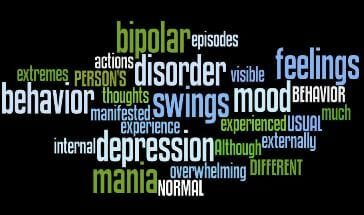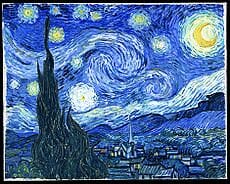What is meant by “bipolar behavior”? How do the internal symptoms of bipolar disorder get “acted out” or displayed?
Bipolar disorder has two dimensions to it:
1. The bipolar symptoms that a person experiences as moods, thoughts and feelings, and
2. The bipolar “signs” that are observable by others, that is, the bipolar person’s behavior – how they display the disorder.

Although bipolar disorder is all about mood swings – the extremes of depression and mania – it is much more than an internal experience of mood swings and overwhelming feelings.
The thoughts and feelings experienced during episodes of mania and depression are manifested in actions – externally visible behavior.
Although the internal experience of bipolar disorder can cause someone a great deal of suffering, it is this external behavior that often causes the person so many problems with their work life, personal life, and social life.1
Diagnosing bipolar through behavior
Bipolar behavior is a critical element of correctly diagnosing bipolar disorder.
Reminder
Bipolar disorder behavior WILL BE DIFFERENT FROM THE PERSON’S NORMAL OR USUAL BEHAVIOR.
A skilled clinician with expertise in bipolar disorder will take a detailed personal and family history. Yes, they will be interested in how the patient describes their moods, and they will also be alert for any family history of bipolar disorder.
HOWEVER, CERTAIN BEHAVIOR MUST ALSO BE PRESENT FOR A DIAGNOSIS OF BIPOLAR I.
According to the American Psychiatric Association’s Diagnostic and Statistical Manual of Mental Disorders, Fourth Edition, 1994 (DSM-IV), there must have been at least one Manic Episode involving some of the following bipolar signs (which are distinct from thoughts or feelings):
1. Decreased need for sleep, for example only sleeping 3 hours a night.
2. More talkative than is usual (taking into consideration what is usual for that person), and/or pressured speech. (Pressured speech is rapid, often loud and difficult-to-interrupt or get a word in type of talking, or talking even where there is not actually anyone listening.)
3. A noticeable increase in goal-directed activity, for example starting new projects at home or work (but usually being unable to finish anything).
4. Excessive levels of involvement in pleasurable but risky activities such as spending sprees, sexual promiscuity or infidelity, or reckless investments or business ventures.
In addition, these bipolar signs (i.e. behaviors) must have serious adverse consequences such as causing problems at work, in personal relationships, or disruptions in normal social activities, OR cause a need for hospitalization to prevent harm to self or others.
NIMH description of bipolar disorder behaviors
Behavior in bipolar takes many forms
What bipolar behavior is NOT
Despite these clear “official” diagnostic indications, there is a lot of confusion about what constitutes bipolar behavior.
Today it is very common for the media and for individuals to label any action they regard as eccentric or annoying as “bipolar”.

Bipolar disorder is a clinical condition with medical diagnostic criteria. Bipolar” is NOT a synonym for obnoxious, annoying, awful, disagreeable, mean, nasty, objectionable, or unpleasant behavior.
Further, “bipolar” is NOT a synonym for erratic, unpredictable, abnormal, bizarre, eccentric, inconsistent, peculiar, unreliable, or weird behavior.
(I could go on, but I’m sure you get the idea.)
The constant use of the word “bipolar” as cultural shorthand for anything we find strange or objectionable is foolish, ignorant, and can potentially cause harm, as it contributes to stigma associated with the disorder.
The upside of bipolar behavior
People with bipolar disorder often do things that have negative consequences that can impact themselves and/or others.
But there is an upside!
Without the behavior, bipolar symptoms of mood alone would be far more difficult to diagnose and manage.
How can “bad” behavior ever be a good thing?
It is both good and useful because it makes the internal and subjective experience of bipolar symptoms objective, observable, and externalized.
This is very important for arriving at an accurate diagnosis.

My own diagnosis (very late in life in my mid-forties) finally happened this way. My psychiatrist was treating me for depression and we had tried some medications that were making me worse instead of better. When I casually mentioned to her some shopping I had done (over $5,000 on Italian designer furniture for a very down-market, temporary grad student apartment when I was making no money), there was an aha moment. These sort of irrational spending sprees are classic bipolar behavior. I had been unable to adequately describe my thoughts and feelings, but this allowed my psychiatrist to ask me about other activities.
It was a conversation that changed – and saved – my life.
Further, if you and your loved ones know the behaviors that indicate you are entering an episode of mania or depression, it is possible to intervene before any damage is done. This can result in a positive spiral. Fewer episodes and relapses improves coping skills and brain health, just as more frequent episodes become a negative spiral.
We also have bipolar prodromes or a bipolar relapse signature, which is bipolar behavior that signals the onset of mania or depression.
Is bipolar behavior always bad?
Absolutely not!We are all aware of the link between bipolar disorder and creativity.
Also, many of the most energetic and resourceful business-people and other leaders have had bipolar disorder.

Just please understand that treatment does not destroy these more positive faces of bipolar. In fact, proper treatment can boost productivity.2
Most of all, here is a key take-away for you. PLEASE remember that bipolar behavior differs from the individual’s usual behavior. Someone with consistently, rather than episodic, bad behavior very likely does NOT have bipolar disorder.
Understand the difference between who you or your loved one REALLY is and the transient, treatable behaviors of bipolar.
References:
1https://www.nimh.nih.gov/health/topics/bipolar-disorder/index.shtml
2https://www.nami.org/learn-more/mental-health-conditions/bipolar-disorder
 Medically reviewed by
Medically reviewed by
2 Comments
My 36 year old daughter has lived with my husband and me since July 2016. Her two sons live with their father in another state. She is a doctorate level professional. Two days ago while her dad and i left the house she burned one if my antique tables in a bonfire outside. She said she didnt like the memories it gave her or the way it smelled.
Two weeks ago she left on foot in 20 degree weather at night for a city hundreds of miles away to get to a job interview in New York city. She had 40 dollars in her pocket. She has no credit cards anymore because of multiple spending sprees. When her father and I went to find her she fought us and spit at me. Twice she has driven to a NYC airport and taken a flight to Italy by herself. She was hospitalized for 2 weeks last year. She lost her job, her marriage, two cars and almost her children. She never has admitted to being bipolar(her official dx). We cannot have her placed in any program unless she goes voluntarily. We have taken her to therapists, psychiatrists and to our county mental health services. Sometimes she takes her medications. When she does she is completely different and even her appearance changes.
When she begins the manic phase we see changes in her looks, her dialogue becomes accusatory and her sleep wake cycles change. I go on survival mode when this happens. But it is affecting me and my marriage. We are retired and were hoping to enjoy these years travelling. But we are afraid to leave her alone in our home as she has already demonstrated a fondness for burning my furniture.
I have bipolar 1 anxiety,depression,narcolepsy,rs,an chronic pain im not getting better I have taken all the meds an nothing is helping